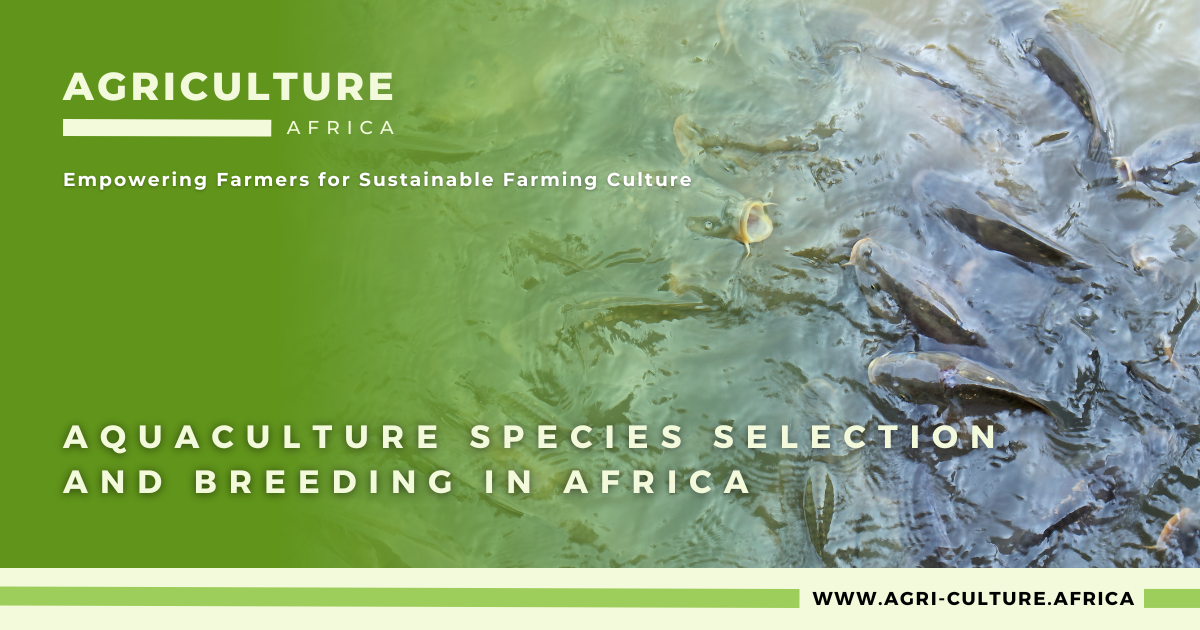
Empowering African Farmers for Sustainable Farming Culture
The success of aquaculture is heavily reliant on selecting the appropriate species of fish or other aquatic animals for farming. The selection of suitable species for aquaculture is influenced by a number of factors, including market demand, seed or fingerling availability, water quality, feed availability, and disease resistance. Genetic improvement, selective breeding, and hybridization are effective methods for increasing the growth rate, disease resistance, and other desirable characteristics of farmed fish species. Aquaculture’s success is also dependent on the adoption of environmentally sustainable practises to reduce negative environmental impacts. African countries can develop a successful and sustainable aquaculture industry that provides food and income to millions of people by taking these factors into account.
The selection of suitable species for aquaculture is influenced by a number of factors, including market demand, seed or fingerling availability, water quality, feed availability, and disease resistance. Tilapia, catfish, and carp are some of the most commonly farmed fish species in Africa. These species are popular due to their hardiness, rapid growth, and tolerance for a wide range of environmental conditions.
Tilapia is one of Africa’s most popular aquaculture fish species. It is simple to culture, has a high tolerance for poor water quality, and grows quickly. Tilapia is also disease resistant and can be cultured in a variety of water bodies, including ponds, lakes, and rivers.
Catfish is another popular aquaculture species in Africa. It is hardy, grows quickly, and is in high demand in local markets. Carp is also a popular aquaculture species in Africa. It’s simple to grow and has a high tolerance for poor water quality.
Other fish species, in addition to those commonly farmed, have the potential for aquaculture in Africa. Among these are African catfish, Nile perch, and African bonytongue. These species have distinctive characteristics that make them suitable for aquaculture in specific African regions.

Selective breeding and genetic improvement are important tools for improving the growth rate, disease resistance, and other desirable characteristics of farmed fish species. Selecting superior individuals with desirable traits and using them as breeding stock to produce offspring with improved traits is what genetic improvement of farmed fish species entails.
Selective breeding entails selecting individuals with desirable characteristics and breeding them to produce offspring with those same characteristics. Selective breeding can be sped up by using molecular tools, such as DNA markers, to identify the genetic markers associated with desired traits.
Several fish species, including tilapia, catfish, and carp, have benefited from genetic improvement through selective breeding. For example, tilapia genetic improvement has resulted in the development of several strains with improved growth rates, disease resistance, and other desirable characteristics.
Another tool for improving the performance of farmed fish species is hybridization. The crossbreeding of two different species or strains to produce offspring with desirable traits is known as hybridization. Improved growth rates, disease resistance, and other desirable traits can result from hybridization.
Several fish species, including tilapia and catfish, have successfully hybridised. Crossbreeding of Nile and blue tilapia, for example, has resulted in the development of several hybrid strains with improved growth rates and disease resistance.
When selecting and breeding fish species for aquaculture, several factors must be considered. These variables include seed or fingerling availability, water quality, feed availability, disease resistance, market demand, and environmental sustainability.
Your donation fuels change! Help Agriculture Culture in Africa empower farmers with resources, training, and access to innovation. Together, we can revolutionize African agriculture.

Empowering Sustainable Growth and Innovation in African Agriculture
Sign up to our newsletter